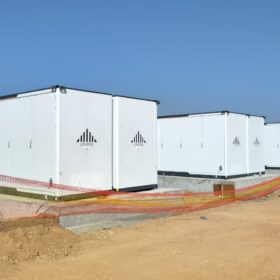PVT-assisted air-source heat pump based on phase-change tank
Scientists in China have designed a photovoltaic-thermal integrated air-source heat pump hot water system that uses a phase change tank to lower energy consumption and achieve higher power generation performance than conventional heat pumps. The system is designed to use water as a working medium and to provide circulation power for forced circulation.
Hybrid solar vanadium battery system withstands Australia’s harsh weather
Energy solutions company Australian Flow Batteries has rolled out its containerised solar vanadium battery system in Western Australia, which can be stowed in less than an hour to protect modules during the region’s annual cyclone season.
Lion Storage closes finance on 1.4 GWh merchant battery in Netherlands
Tesla will provide 372 of its MegaPack 2 XL battery systems as well as engineering, procurement, and construction (EPC) services.
California Energy Commission announces $55 million in funding to build out EV charger network
The CEC estimates that approximately 24,000 new chargers were installed in the first half of 2024, and the Fast Charge California Project aims to incentivize even more.
The Hydrogen Stream: H2 projects in Algeria and Mauritania under the spotlight
As Saudi-Algerian researchers report on the northern African country’s hydrogen potential, Denmark’s GreenGo Energy starts its 6 GW electrolysis hydrogen project in Mauritania.
Argentina launches 500 MW storage auction
The Argentinean authorities plan to install the new storage capacity in critical nodes of the metropolitan area of Buenos Aires, with an estimated investment of $500 million and an execution period of between 12 and 18 months.
Problems with Brazil’s planned battery auction
A crippling tax burden; an inability to bank energy arbitrage income; and uncertainty about grid fees, network ancillary payments, and solar-plus-storage eligibility could all affect a procurement exercise planned for June.
1 GWh battery tender opened in India
India’s state-controlled National Hydroelectric Power Corporation (NHPC) Ltd. will act as middle man between successful developers and power distribution companies in the state of Andhra Pradesh.
BYD to supply 12.5 GWh of battery storage in Saudi Arabia
Following a report in January, BYD has now officially secured the 12.5 GWh battery energy storage system (BESS) supply deal.
PV-driven solar water pumping system based on supercapacitor buffer
Scientists have proposed a novel design for standalone solar PV water pumping systems, using an intermediate supercapacitor buffer to temporarily store solar energy and release it in high-power pulses. Daily water productivity has grown by 64%, based on a simulation. An experimental setup was also tested.










